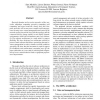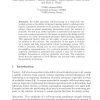116 search results - page 19 / 24 » Autonomous Coordination in Sensor Networks: Heterogeneous AD... |
GLOBECOM
2007
IEEE
14 years 2 months ago
2007
IEEE
— An opportunistic large array (OLA) is a form of cooperative diversity in which a large group of simple, inexpensive relays or forwarding nodes operate without any mutual coordi...
WICSA
2004
13 years 9 months ago
2004
Research domains such as active networks, ad-hoc networks, ubiquitous computing, pervasive computing, grid computing, and sensor networks, clearly show that computer networks will...
ATAL
2005
Springer
14 years 1 months ago
2005
Springer
Many multi-agent systems consist of a complex network of autonomous yet interdependent agents. Examples of such networked multi-agent systems include supply chains and sensor netw...
IWCMC
2006
ACM
14 years 1 months ago
2006
ACM
Self-Organized Networks (SONs) are a general description of autonomous networks without infrastructure, of which Ad Hoc, Sensor and Mesh networks are special cases. We had previou...
ICDCN
2009
Springer
13 years 5 months ago
2009
Springer
Abstract. We define geometric self-structuring in a large-scale networked system as the ability of the participating nodes to collaboratively impose a geometric structure to the ne...


